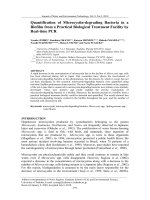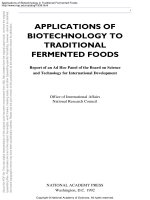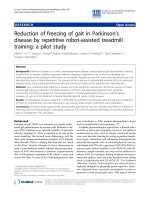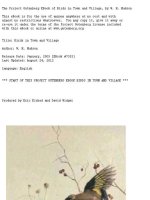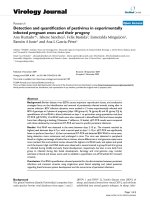Quantification of trans-resveratrol in Rhizoma reynoutriae japonicae by HPLC
Bạn đang xem bản rút gọn của tài liệu. Xem và tải ngay bản đầy đủ của tài liệu tại đây (181.92 KB, 5 trang )
JOURNAL OF MILITARY PHARMACO-MEDICINE No7-2015
QUANTIFICATION OF TRANS-RESVERATROL
IN Rhizoma reynoutriae japonicae BY HPLC
Hoang Van Tan*; Trinh Nam Trung**; Hoang Viet Dung**
Nguyen Van Bach**; Nguyen Trong Diep**
SUMMARY
Objectives: Establishing a HPLC method that was suitable with current conditions of the
laboratory to quantification of trans-resveratrol in Rhizoma reynoutriae japonicae. Material and
methods: Parameters of the established method are validated including: linear range, precision,
accuracy... Results: Chromatographic conditions of the method: using Sunfire RP-18 column,
acetonitrile and 0.1% formic acid as mobile phase following a multi-step gradient program,
monitored at 305 nm. The established method had the high precision (RSD = 1.65%) and high
accuracy (recovery ratio = 97.32 - 102.47%, average = 99.13%, RSD = 1.14%). Conclusion:
A suitable HPLC method for quantifying trans-resveratrol in Rhizoma reynoutriae japonicae
was validated.
* Key words: Rhizoma reynoutriae japonicae; Trans-resveratrol; HPLC.
INTRODUCTION
Reynoutria japonica Hautt was used to
treat diseases based on traditional experience,
including: treating pain of arthritis by
rheumatism, swell and pain by trauma,
persistant pain… [6]. Information of articles
indicated trans-resveratrol in Rhizoma
reynoutriae japonicae possesses some
interesting bioactivities, specially, the effect
of modulating blood lipid status [1]. So, we
selected this compound as a bioactive
marker for controlling quality of medicinal
plants as well as semi-products or endproducts afterwards. According to references,
there were some researches of establishing
HPLC methods for determinating transresveratrol together with other compounds
[2, 3, 5]. However, these results were not
in accordance with our research target
being only to quantify the content of transresveratrol. Besides, our laboratory conditions
were different from the published ones.
Therefore, this research was carried out
to establish HPLC method for determinating
trans-resveratrol in Rhizoma reynoutriae
japonicae that was suitable for our laboratory
conditions and research target.
MATERIALS AND METHODS
1. Materials and equipment.
- Materials: Rhizoma reynoutriae japonicae
was harvested in Sapa district, Laocai
province in 01 - 2015.
- Solvents: acetonitrile (ACN) (Merck,
HPLC grade), 0.1% formic acid (Merck,
analytical grade).
* Hospital of Military Region 4
** Vietnam Military Medical University
Corresponding author: Hoang Viet Dung ()
3
JOURNAL OF MILITARY PHARMACO-MEDICINE No7-2015
- Chemical: trans-resveratrol (content
98%, provided by Centre of Pharmaceutical
Research and Training, Vietnam Military
Medical University).
- Equipment: analyzing by waters
HPLC system (Sunfire RP-18 column;
autosamples 2695; deetector PDA 2998;
empower sofware), extraction by Elmasonic
machine, analysis balance of Mettler Toledo…
RESULTS AND DISCUSSION
1. System suitability.
For evaluating system suitability, carrying
out to inject a standard solution 6 times
repeatedly into the HPLC system [4].
Results were showed in table 1.
Table 1: Results of evaluating system
suitability.
2. Methods.
- Chromatographic conditions:
CONTENT
RESULT
Peak area (µV*s)
S = 338,479
RSD = 0.90%
Retention time (minute)
tR = 16.46
RSD = 0.05%
+ Detector UV: 305 nm.
+ Injection volume: 20 µL.
+ Column temperature: 280C.
+ A multistep gradient program of mobile
phase: 0 - 18 min, CAN - 0.1% formic acid
(25:75, v/v); 18 - 19 min from 20 to 80%
ACN; 19 - 29 min, ACN - 0.1% formic acid
(80:20, v/v); 29 - 30 from 80 to 25% ACN;
30 - 40 min, CAN - 0.1% formic acid
(80:20, v/v).
Tailing factor
1.09
Plate count
> 10,000
0.010
0.008
0.006
0.004
AU
+ Flow rate: 1.0 mL/minute.
0.002
0.000
-0.002
- Sample solution preparation:
-0.004
- Standard solution preparation:
0.00
1.00
2.00
3.00
4.00
5.00
6.00
7.00
8.00
9.00
Minutes
10.00
11.00
12.00
13.00
14.00
15.00
16.00
17.00
18.00
Figure 1: Chromatogram of the blank sample.
res v eratrol - 16.466
0.020
0.018
0.016
0.014
0.012
0.010
AU
0.5 g pulverized Rhizoma reynoutriae
japonicae was ultrasonically extracted
with about 45 mL of methanol for 60 min
(repeatedly 4 times). All of extraction
solutions were collected in a 200 mL
volumetric flask. This solution is filtered
through a 0.45 μm filter membrane. The
filtrate (20 μL) was injected into the HPLC
system for analysis.
0.008
0.006
0.004
0.002
6.2 mg trans-resveratrol is dissolved
by methanol in a 50 mL volumetric flask
(stock standard solution). From stock
standard solution, carrying out to dilute
using solvent of methanol and volumetric
flasks to obtain working standard solutions.
4
0.000
-0.002
-0.004
0.00
1.00
2.00
3.00
4.00
5.00
6.00
7.00
8.00
9.00
Minutes
10.00
11.00
12.00
13.00
14.00
15.00
Figure 2: Chromatogram of a
standard solution.
16.00
17.00
18.00
JOURNAL OF MILITARY PHARMACO-MEDICINE No7-2015
5 concentrations of trans-resveratrol and
analyze these solutions [4]. Results were
showed in table 2 and figure 4.
0.12
0.10
resveratrol - 16.441
AU
0.08
0.06
0.04
0.02
Table 2: Correlation between peak areas
and concetrations of trans-resveratrol.
CONCENTRATION (µg/ml)
PEAK AREA (µV*s)
1.22
116,445
Figure 3: Chromatogram of a
sample solution.
3.04
339,568
6.08
708,856
The result in table 1 showed the
repeatibility of peak areas and the
retention times were good (both RSD < 1%).
Peak of trans-resveratrol is sharp and
proportional with tailing factor = 1.09. Plate
count was more than 10,000. Therefore,
the chromatography system is suitable for
analyzing samples.
9.11
1,082.241
12.2
1,436.228
0.00
0.00
1.00
2.00
3.00
4.00
5.00
6.00
7.00
8.00
9.00
Minutes
10.00
11.00
12.00
13.00
14.00
15.00
16.00
17.00
18.00
S (μV*s)
2. Specificity.
Retention times of the peak in the
chromatogram of sample solution and in
the chromatogram of standard solution
are coincident. At this retention time,
there was no peak in the chromatogram
of blank sample. Match coefficients,
determinated at 7 points in peak of a
sample solution by comparison between
the UV-Vis geometry at these points and
that of standard trans-resveratrol using
PDA detector, were from 0.992 to 0.997.
These results proved that the established
method has the high specificity.
3. Linear range.
For evaluating the linear range of the
established method, carrying out to prepare
C (μg/mL)
Figure 4: Graph of linear correlation between
peak areas and concentrations of
trans-resveratrol.
The result of figure 4 showed that there
was linear correlation between peak areas
and concentrations of trans-resveratrol following
the regression equation y = 120603x - 26752
with correlation coefficient R2 = 0.9998.
5
JOURNAL OF MILITARY PHARMACO-MEDICINE No7-2015
4. Precision.
Table 4: Results of evaluating accuracy.
Precision of the established method
was evaluated based on determinating
repeatibility of 6 individual experiments by
extration and quantifying trans-resveratrol
in the materials 6 times repeatedly [4].
Results were showed in table 3.
N0
ADDITION
AMOUNT (µg)
RECOVERY
AMOUNT (µg)
RECOVERY
1
486
472.99
97.32
2
486
498.00
102.47
3
486
474.62
97.66
4
486
477.44
98.24
5
486
476.95
98.14
6
486
490.54
100.93
RATIO (%)
Table 3: Results of evaluating precision.
N0
PEAK AREA
(µV*s)
CONTENT OF TRANSRESVERATROL IN MATERIALS
(%)
1
258727
0.0862
2
258329
0.0860
3
267112
0.0887
4
268729
0.0892
5
260163
0.0866
6
267198
0.0887
Statistic
Average content = 0.0876 (%)
RSD = 1.65%
The result in table 3 showed the
established method had the high repeatibility
with RSD = 1.65%. The content of transresveratrol in Rhizoma reynoutriae japonicae
harvested in Sapa district was 0.0876%.
Statistic
Average recovery ratio =
99.13% RSD = 1.14%
The result in table 4 showed the
established method has the high accuracy
with recovery ratio = 97.32 - 102.47%,
RSD = 1.14%.
6. LOD and LOQ.
By diluting standard solutions of transresveratrol and analyzing with the HPLC
system, LOD and LOQ of the established
method were determinated based on
signal to noise [4]. LOD was about 0.03
μg/mL and LOQ was about 0.1 μg/mL.
5. Accuracy.
Accuracy of the established method
was evaluated by adding an exact amount
of trans-resveratrol into the sample of
Rhizoma reynoutriae japonicae. Then,
determinating recovery ratio by comparing
an recovery amount to an addition amount
of trans-resveratrol [4].
Samples were injected 6 times repeatedly
into the HPLC system. Results were showed
in table 4.
6
CONCLUSION
A suitable method had been developed
and validated for quantifying trans-resveratrol
in Rhizoma reynoutriae japonicae. The
established method had precision and
accuracy. This study also provided valuable
information for the content of trans-resveratrol
in Rhizoma reynoutriae japonicae harvested
in Sapa district being about 0.0876%.
JOURNAL OF MILITARY PHARMACO-MEDICINE No7-2015
REFERENCES
1. Arichi H, Kimura Y, Okuda H et al.
Effects of stilbene components of the roots of
Polygonum cuspidatum Sieb. et Zucc. on lipid
metabolism. Chem Pharm Bull. 1982, 30 (5),
pp.1766-1770.
2. Chinese Pharmacopoeia. 2005, 1454,
pp.180-181.
3. Dionex. Determination of anthraquinones
and stilbenes in Giant Knotweed Rhizome
by HPLC with UV detection. Application
note 232.
4. ICH guidelines. Q2 (R1) validation of
analytical procedures: text and methodology.
1996.
5. Laszlo Mark, Martin S. Pour Nikfardjam,
Peter Avar et al. A validated HPLC method for
the quantitative analysis of trans-resveratrol
and trans-piceid in Hungarian wines. Journal
of Chromatographic Science. 2005, Vol 43,
pp.445-449.
6. National Institute of Medicinal Materials.
Medicinal plants and animals in Vietnam.
Publishing house of Science and Technology.
Hanoi. 2004, pp.529-531.
7
